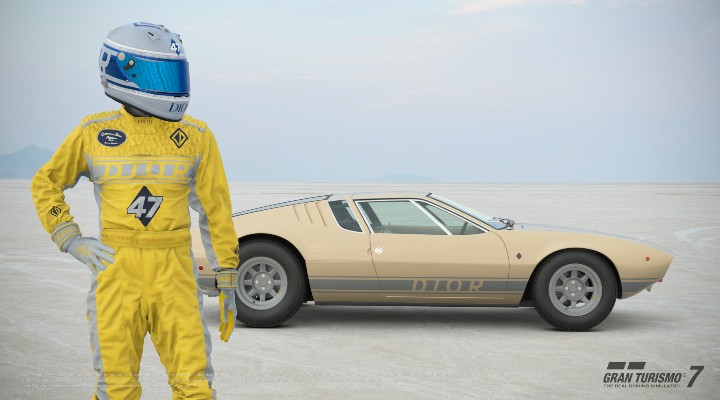Italian fashion house Dior recently announced a collaboration with one of the most popular racing car games, Gran Turismo 7, during the Gran Turismo World Series Showdown in Salzburg, Austria. This is the luxury fashion brand’s debut in digital games and pays homage to Christian Dior’s first trailblazing fashion show, back in 1947. Created in partnership with Polyphony Digital – developers of Gran Turismo 7 and a subsidiary of Sony Interactive Entertainment – the digital Dior assets incl
nclude a racing suit and customised, cream-coloured De Tomaso Mangusta, an Italian sports car manufactured between 1967 and 1971.
These in-game items feature the Dior oblique motifs, ‘CD’ diamond initials, and a “Christian Dior Atelier Avenue Montaigne” patch in a style similar to what you would have seen in the ’60s and ’70s. The cream-coloured sports car exterior features the number “47”, as a tribute to 1947.
The in-game digital avatar skin has been designed by Dior men’s artistic director Kim Jones. It consists of a yellow and grey racing suit, matching gloves, reinterpreted Diorizon shoes, and blue and grey helmet.
From 25 August, Gran Turismo 7 players will be able to apply the new and exclusive racing gear to their driver avatar in the game.
Inspirations for the designs were drawn from the glamourous Dior perfume adverts from the ’60s through the ’80s, which conveyed a luxurious lifestyle. During this era, high-end perfume brands sponsored famous car races, such as the Dakar Rally and the 24 Hours of Le Mans.
This collaboration is vastly different to when other premium brands have made in-game skins for AAA games or created their own digital games and mini-games on platforms such as Roblox. The high-definition graphics and realistic look of Dior’s racing gear showcase a more elevated style that appeals to a Gran Turismo audience that has a love of luxury sports cars both modern and vintage.
It might not be Dior’s usual style to design a racing suit and customise a sports car; however, the result is a highly sophisticated ensemble and sports car fit for real-life races. It makes you wonder why it has taken so long for games to take fashion seriously.
How fashion can make better games
With a well-known fashion designer driving the Dior x Gran Turismo collaboration, it’s clear that fashion designers bring a valuable perspective to digital games, one that steers away from the busty babes in skimpy warrior costumes that have been commonplace since the early days of video games.
You won’t necessarily hear game designers and developers talking about the importance of fashion, although maybe we should, with the lack of diversity and representation in both game narratives and characters.
In 2019, during Melbourne International Games Week, I attended a talk by Victoria Tran, a Canadian communications and community manager in the games industry. She shared insights about the importance of fashion in games.
“Fashion in games is one of the most downplayed parts of the medium, yet it provides a sense of immersion, comfort, and identity in characters while simultaneously empowering gamers of all kinds,” Victoria said in an article published shortly after the session.
For the most part, the game design and development space is male-dominated. However, when it comes to those who play games regularly, recent statistics showed that 45 per cent of gamers identify as female – an audience that is regularly overlooked in the games industry.
Skills gap stands in the way
It’s not entirely the industry’s fault for not offering a broad spectrum of representation in character identities. There’s a gap in skills and knowledge worldwide, and for indie games and small studios, tight budgets restrict access to consultants who specialise in fashion for games.
The course co-ordinator for Torrens University’s game design and development program, Trent Naylor, said, “Game asset creation is a specialised form of computer graphics (CG) work and so there is a lot of knowledge required to create the assets. Some modern tools, such as Marvelous Designer and Clo3D, bridge that gap. However, there is a skills shortage on the fashion side, due to game asset creation being considered closer to fantasy costume design than traditional fashion design techniques.
The Dior racing suit for Gran Turismo 7 is an excellent example of transferring specialist design skills into virtual environments. Dior’s Jones saw an opportunity to collaborate with a digital game respected for its high-quality graphics and realistic style. The alignment provides a platform for equally sophisticated design assets to be applied.
This area is fast becoming an industry of its own, proving that the hybrid skills of fashion design and CG asset creation will be sought after.
The games industry is changing and it is in need of diverse drivers with new skill sets and a precise eye for fashion and design.

